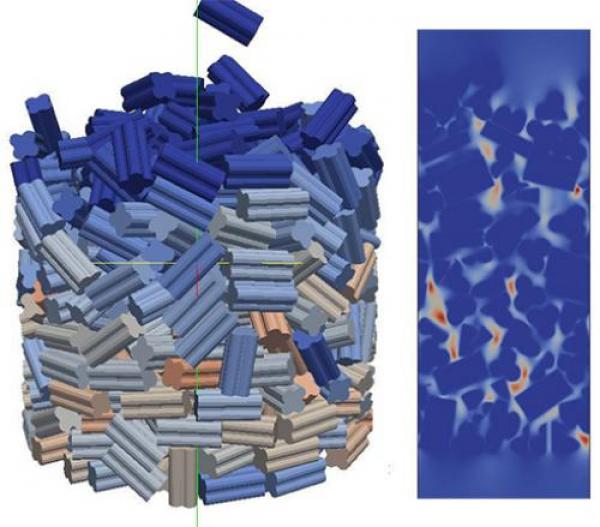The catalysts developed by IFPEN are often used in fixed-bed reactors where their grains are packed randomly. For testing them in pilot units, one of the challenges is to guarantee representativity at lower cost, and at the same time improving repeatability. It is therefore important to ensure that both a satisfactory reactor configuration and a filling procedure can be proposed.
To assess the uncertainties associated with random effects, a switch to virtual (in silico) experiments has been suggested. To this end, numerical tools have been developed capable of simulating reacting flows in fixed-bed reactors, on a local scale. Given the fine mesh required and the representative dimensions of our systems, current calculation powers make it possible to simulate our usual reactors with a diameter of around 15 mm.
The first step in a calculation is the simulation of catalyst packing using the Grains3D code(1) (figure). The next step involves calculating the flow of the fluid in the space between the grains, using the PeliGRIFF code(2) (figure). For mass and heat transfer calculations, solvers have been developed on the basis of OpenFOAM, open source library.

Thanks to these developments, IFPEN has operational tools to perform virtual experiments. The first calculations including both thermal and mass transfer data have confirmed the relevance of these technical choices.
The research under way is focusing on the identification of criteria for mesh convergence. In the short term, the simulation of even smaller reactors is planned, along with the definition of a criterion concerning the effects of catalyst dilution.
(1) M. Rolland, A.D. Rakotonirina, A. Devouassoux, J. L. Barrios Goicetty, J. Y. Delenne & A. Wachs, (2019) Predicting average void fraction and void fraction uncertainty in fixed beds of poly-lobed particles. Accepted in IECR.
(2) F. Dorai, C. M. Teixeira, M. Rolland, E. Climent, M. Marcoux & A. Wachs, (2015). CES, 129, 180-192
Scientific contact: Matthieu Rolland





